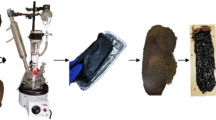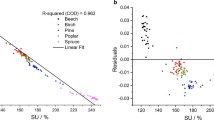Abstract
In this study, a commercial kraft lignin (KL) was used as the raw material to prepare phenolic resin (PF) based on a detailed analysis of its molecular structure. To further increase the viscosity of the phenolic resins and improve their environmental performance, demethylated and hydroxymethylated KL (DKL and HKL) were also prepared and used to produce DKLPF and HKLPF. Compared with the methoxy content of KL, that of DKL was lower by 39.34%, and the alcoholic hydroxyl contents of HKL were higher by 59.39%. Therefore, the increased active sites on the benzene ring of DKL promote the hydroxymethylation reaction, and HKL adds more methylol groups, which is more conducive to the condensation reaction to produce PF. The synthesis process and properties of the lignin-based PF with high phenol substitution rates were investigated. The results showed that the maximum substitution rates of KL, DKL, and HKL to replace phenol to prepare phenolic resin were 70%, 50%, and 30% (w/w). The viscosity, free formaldehyde content, and other important indices of LPF meet the requirements of the GB/T14732-2017 standard. Besides, as the substitution rate of phenol by lignin increases, the viscosity of DKLPF and HKLPF performance is higher. When the 30% (w/w) phenol was replaced by lignin, the adhesive strengths of KLPF, DKLPF, and HKLPF all reached the maximum, and the trend of adhesive strengths was KLPF < DKLPF < HKLPF.




Similar content being viewed by others
References
Ahvazi B, Cloutier E, Wojciechowicz O, Ngo TD (2016) Lignin profiling: a guide for selecting appropriate lignin as precursors in biomaterials development. ACS Sustain Chem Eng 4(10):5090–5105
Aini N, Othman N, Hussin MH, Sahakaro K, Hayeemasae N (2019) Hydroxymethylation-modified lignin and its effectiveness as a filler in rubber composites. Processes 7(5):315–336
Alonso MV, Oliet M, Pérez JM, Rodríguez F, Echeverría J (2004) Determination of curing kinetic parameters of lignin–phenol–formaldehyde resol resins by several dynamic differential scanning calorimetry methods. Thermochim Acta 419:161–167
Alvaro T, Cristina P, Jalel L, Juan ME, Iñaki M (2007) Physico-chemical characterization of lignins from different sources for use in phenol-formaldehyde resin synthesis. Biores Technol 98:1655–1663
Argyropoulos D (1994) Quantitative phosphorus-31 NMR analysis of six soluble lignins. J Wood Chem Technol 14(1):65–82
Chai Y, Liu J, Zhao Y, Zhao Y, Yan N (2016) Characterization of modified phenol formaldehyde resole resins synthesized in situ with various boron compounds. Ind Eng Chem Res 55(37):9840–9850
Chen Y, Gong XW, Yang GS, Li Q, Zhou N (2019) Preparation and characterization of a nanolignin phenol formaldehyde resin by replacing phenol partially with lignin nanoparticles. RSC Adv 9:29255–29262
Chen Y, Zhang H, Zhu Z, Fu S (2020) High-value utilization of hydroxymethylated lignin in polyurethane adhesives. Int J Biol Macromol 152:775–785
Effendi A, Gerhauser H, Bridgwater AV (2008) Production of renewable phenolic resins by thermochemical conversion of biomass: a review. Renew Sustain Energy Rev 12:2092–2116
Fleckenstein M, Biziks V, Mai C, Holger M (2018) Modification of beech veneers with lignin phenol formaldehyde resins in the production of laminated veneer lumber (LVL). Eur J Wood Products 76:843–851
Gilca IA, Ghitescu RE, Puitel AC, Popa VI (2014) Preparation of lignin nanoparticles by chemical modification. Iran Polym J 23(5):355–363
Gravitis J, Abolins J, Tupciauskas R, Veveris A (2010) Lignin from steam-exploded wood as binder in wood composites. J Environ Eng Landsc Manage 18(2):75–84
Hu LH, Pan H, Zhou YH, Hes CY, Liu CG, Zhang BF (2014) Chemical groups and structural characterization of lignin via thiol-mediated demethvlation. J Wood Chem Technol 34(2):122–134
Hussin MH, Rahim AA, Ibrahim MNM, Brosse N (2013) Physicochemical characterization of alkaline and ethanol organosolv lignins from oil palm (Elaeis guineensis) fronds as phenol substitutes for green material applications. Indus Crops Prod 49:23–32
Khan MA, Ashraf SM (2005) Development and characterization of a lignin-phenol-formaldehyde wood adhesive using coffee bean shell. J Adh Ence Technol 19(6):493–509
Li JJ, Wang W, Zhang SF, Gao Q, Zhang W, Li JZ (2016) Preparation and characterization of lignin demethylated at atmospheric pressure and its application in fast curing biobased phenolic resins. RSC Adv 6(71):67435–67443
Li M, Yoo CG, Pu Y, Ragauskas AJ (2017) 31P NMR chemical shifts of solvents and products impurities in biomass pretreatments. ACS Sustain Chem Eng 6(1):1265–1270
Li N, Li Y, Yoo CG, Yang X, Lin X, Ralph J, Pan X (2018) An uncondensed lignin depolymerized in the solid state and isolated from lignocellulosic biomass: a mechanistic study. Green Chem 20(18):4224–4235
Li NZ, Chen ZG, Zhang YF (2019) Preparation and characterization of phenol formaldehyde resin adhesives modified by the phenolic lignin. Chem Indus for Prod 39:95–101
Lin ZX, Ouyang XP, Yang DJ, Deng YH, Qiu XQ (2010) Effect of hydroxvmethylation of lignin on the properties of lignin-phenol-formaldehyde resins. World Sci-Tech RandD 32:348–351
Ma Y, Zhao X, Chen X, Wang Z (2011) An approach to improve the application of acid-insoluble lignin from rice hull in phenol-formaldehyde resin. Colloids Surf, A 377(1–3):284–289
Malutan T, Nicu R, Popa VI (2008) Contribution to the study of hydroxymethylation reaction of alkali lignin. BioResources 3(1):13–20
Mohamad Ibrahim MN, Ghani AM, Nen N (2007) Formulation of lignin phenol formaldehyde resins as a wood adhesive. Malaysian J Anal Sci 11(1):213–218
Okamoto T, Takeda H, Funabiki T, Takatani M, Hamada R (1996) Fundamental studies on the development of lignin-based adhesives, I. catalytic demethylation of anisole with molecular oxygen. React Kinet Catal Lett 58(2):237–242
Qiao W, Li S, Guo G, Han S, Ren S, Ma Y (2015) Synthesis and characterization of phenol-formaldehyde resin using enzymatic hydrolysis lignin. J Ind Eng Chem 21:1417–1422
Springer SD, He J, Chui M, Little RD, Foston M, Butler A (2016) Peroxidative oxidation of lignin and a lignin model compound by a manganese SALEN derivativef. ACS Sustain Chem Eng 4(6):3212–3219
Stücker A, Schütt F, Bodo S, Ralph L (2016) Lignins from enzymatic hydrolysis and alkaline extraction of steam refined poplar wood: utilization in lignin-phenol-formaldehyde resins. Ind Crops Prod 85:300–308
Tejado A, Pena C, Labidi J, Mondragon I (2007) Physico-chemical characterization of lignins from different sources for use in phenol-formaldehyde resin synthesis. Biores Technol 98(8):1655–1663
Teodor M, Raluca N, Popa VI (2007) Contribution to the study of hydroxymetylation reaction of alkali lignin. BioResources 3(1):13–20
Vishtal A, Kraslawski A (2011) Challenges in industrial applications of technical lignins. BioRes 6(3):3547–3568
Wang H, Eberhardt TL, Wang C, Gao S, Pan H (2019) Demethylation of alkali lignin with halogen acids and its application to phenolic resins. Polymers 11(11):1771–1787
Wu SB, Zhan HY (2001) Characteristics of demethylated wheat straw soda lignin and its utilization in lignin-based phenolic formaldehyde resins. Cellul Chem Technol 35(3):253–262
Xia CL, Guo TF, Xu YZ, Wang CP (2016) Preparation and structural characterization of hydroxymethylated lignin assisted by microwave irradiation. Biomass Chem Eng 50:12–16
Xie S, Sun Q, Pu Y, Lin F, Sun S, Wang X, Ragauskas AJ (2017) Advanced chemical design for efficient lignin bioconversion. ACS Sustain Chem Eng 5(3):2215–2223
Xu YR, Guo LF, Zhang HN, Zhai HM, Ren H (2019) Research status, industrial application demand and prospects of phenolic resin. RSC Adv 9(50):28924–28935
Zhang W, Ma YF, Wang CP, Li S, Zhang M, Chu FX (2013a) Preparation and properties of lignin-phenol-formaldehyde resins based on different biorefinery residues of agricultural biomass. Ind Crops Prod 43:326–333
Zhang W, Ma YF, Xu YZ, Wang CP, Chu FX (2013b) Lignocellulosic ethanol residue-based lignin-phenol-formaldehyde adhesive. Int J Adh Adhesiv 40:11–18
Zhang HN, Ren H, Zhai HM (2021) Analysis of phenolation potential of spruce kraft lignin and construction of its molecular structure model. Ind Crops Prod 167:113506
Zhao LW, Griggs BF, Chen CL, Hse CY (1994) Utilization of softwood kraft lignin as adhesive for the manufacture of reconstituted wood. J Wood Chem Technol 14(1):127–145
Acknowledgements
The project was supported by the foundation (No. KF 201803) of state key laboratory of biobased material and green papermaking, Qilu University of Technology, Shandong Academy of Sciences. The authors are also grateful for the support of the National Key Basic Research Program of China (No. 202010298105Y). The work was also supported by the Nanjing Forestry University Outstanding Youth Fund (No. NLJQ 2015-5). The research did not receive any specific Grant from funding agencies in the public, commercial, or not-for profit sectors.
Author information
Authors and Affiliations
Corresponding author
Ethics declarations
Conflict of interest
The authors declare that there is no conflict of interest related to this article.
Additional information
Publisher's Note
Springer Nature remains neutral with regard to jurisdictional claims in published maps and institutional affiliations.
Rights and permissions
Springer Nature or its licensor holds exclusive rights to this article under a publishing agreement with the author(s) or other rightsholder(s); author self-archiving of the accepted manuscript version of this article is solely governed by the terms of such publishing agreement and applicable law.
About this article
Cite this article
Liu, Q., Xu, Y., Kong, F. et al. Synthesis of phenolic resins by substituting phenol with modified spruce kraft lignin. Wood Sci Technol 56, 1527–1549 (2022). https://doi.org/10.1007/s00226-022-01408-8
Received:
Accepted:
Published:
Issue Date:
DOI: https://doi.org/10.1007/s00226-022-01408-8




